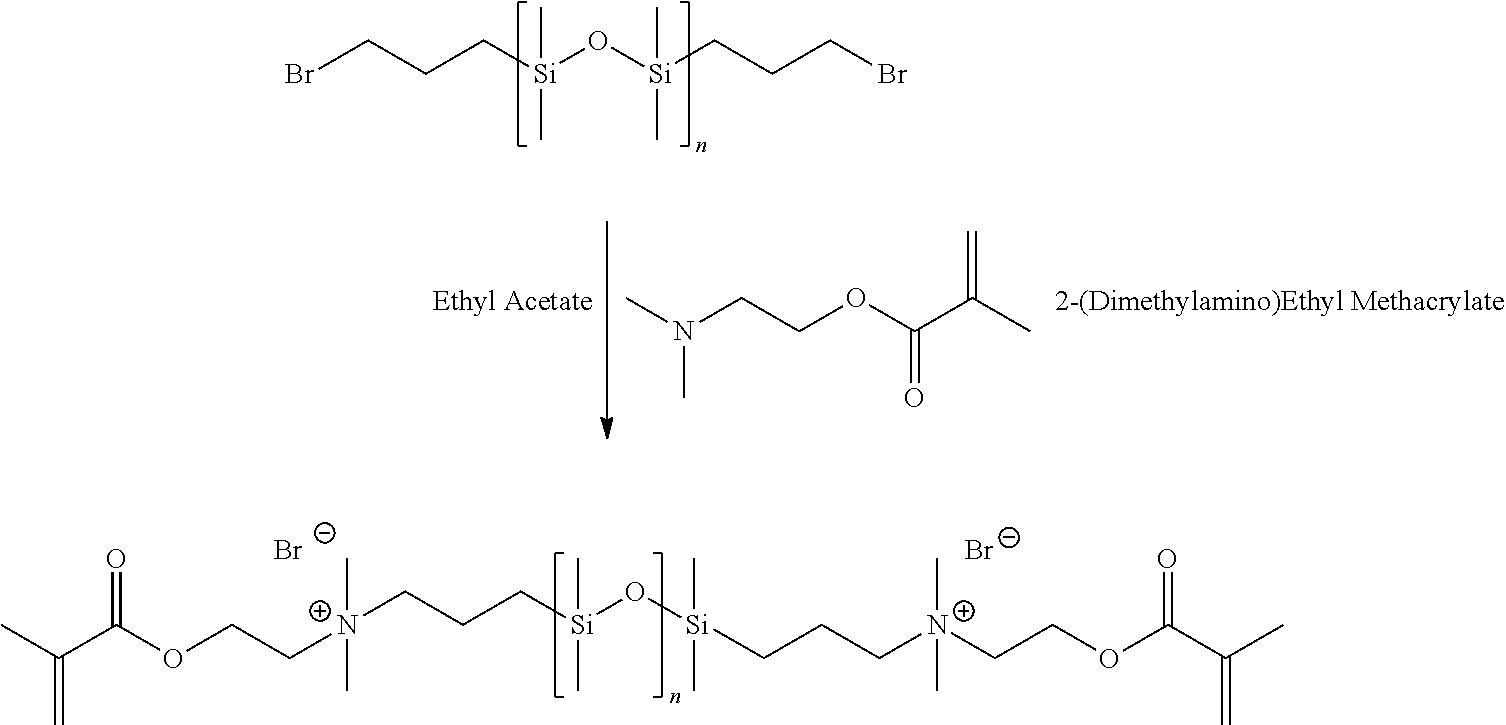Synthesis of cationic siloxane prepolymers
a technology of cationic siloxane and prepolymer, which is applied in the field of synthesizing cationic siloxane prepolymer, can solve the problems of premature polymerization of reaction product, emulsification and fractionation of product, etc., and achieve the effect of easy isolation
- Summary
- Abstract
- Description
- Claims
- Application Information
AI Technical Summary
Benefits of technology
Problems solved by technology
Method used
Image
Examples
example 1
Synthesis of 1,3-bis(4-bromobutyl)tetramethyldisiloxane RD-1862 “Iodo M2D39 Plus”
[0071]This example details the synthetic procedure for the production of the intermediate, 1,3-bis(4-bromobutyl)tetramethyldisiloxane.
I. Preparation of 1,3-bis(4-bromobutyl)tetramethyldisiloxane
[0072]
Materials[0073]1,3-bis(4-hydroxybutyl)tetramethyldisiloxane, vacuum stripped at 60° C. and 0.6 mbar for 2 hours[0074]Aliquot® 336 (reg. trademark of Henkel Corporation), as received Toluene (99.5%), as received[0075]Hydrobromic acid (48%) aqueous HBr), as received[0076]Saturated NaCl[0077]0.5 M Sodium Bicarbonate solution[0078]Magnesium Sulfate (anhydrous), as received[0079]Silica gel 60 (E. Merck 7734-4), as received[0080]Heptane (99%), as received[0081]Methylene chloride (99.5%), as received
Equipment[0082]5 L 3-neck round bottom Morton flask[0083]Teflon bladed mechanical stirrer[0084]Condenser[0085]Thermometer[0086]6 L separatory funnel[0087]Vacuum filtration apparatus[0088]House (low) vacuum setup[0089]V...
example 2
Synthesis of Poly(dimethylsiloxane) Terminated with Cationic Polymerizable Functionality (RD-1862 “Iodo M2D39 Plus”)
[0107]
[0108]This example details the synthetic procedure for the production of the final product, cationic methacrylate terminated poly(dimethylsiloxane), “Iodo M2D39 Plus”.
Materials
[0109]Drierite (8 mesh), as received[0110]1,3-bis(4-bromobutyl)tetramethyldisiloxane (96.5%), as received[0111]Octamethylcyclotetrasiloxane (D4) (98%), as received[0112]Trifluoromethanesulfonic acid (98%), as received[0113]Sodium bicarbonate (99.7%), as received[0114]Celite 503, as received[0115]Acetone (99%), as received[0116]Dry ice, as received[0117]1,4-Dioxane (anhydrous, 99.8%), as received[0118]2-(Methylamino)ethanol (98%), as received[0119]Chloroform (anhydrous, 99%), as received[0120]Brine solution[0121]Deionized water[0122]Magnesium sulfate (anhydrous), as received[0123]Triethylamine (99.5%), as received[0124]2,6-Di-tert-butyl-methylphenol (BHT) (99%), as received[0125]Methacryloyl...
example 3
Synthesis of RD-1862 “Iodo M2D29 Plus”
Purpose
[0195]This document details the synthetic procedure for the production of the intermediate, 1,3-bis(4-bromobutyl)tetramethyldisiloxane and the final product, cationic methacrylate terminated poly(dimethylsiloxane), “Iodo M2D39 Plus”.
I. Preparation of 1,3-bis(4-bromobutyl)tetramethyldisiloxane
[0196]
Materials[0197]1,3-bis(4-hydroxybutyl)tetramethyldisiloxane, vacuum stripped at 60° C. and 0.6 mbar for 2 hours[0198]Aliquot® 336 (reg. trademark of Henkel Corporation), as received from Aldrich[0199]Toluene (99.5%), as received from Aldrich[0200]Hydrobromic acid (48%) aqueous HBr), as received from Aldrich[0201]Saturated sodium chloride solution[0202]0.5 M Sodium bicarbonate solution[0203]Magnesium sulfate (anhydrous), as received from Fisher Scientific[0204]Silica gel 60 (E. Merck 7734-4), as received[0205]Heptane (99%), as received from Aldrich[0206]Methylene chloride (99.5%), as received from Aldrich
Equipment[0207]5 L 3-neck round bottom Mor...
PUM
| Property | Measurement | Unit |
|---|---|---|
| boiling point | aaaaa | aaaaa |
| thickness | aaaaa | aaaaa |
| width | aaaaa | aaaaa |
Abstract
Description
Claims
Application Information
 Login to View More
Login to View More - R&D
- Intellectual Property
- Life Sciences
- Materials
- Tech Scout
- Unparalleled Data Quality
- Higher Quality Content
- 60% Fewer Hallucinations
Browse by: Latest US Patents, China's latest patents, Technical Efficacy Thesaurus, Application Domain, Technology Topic, Popular Technical Reports.
© 2025 PatSnap. All rights reserved.Legal|Privacy policy|Modern Slavery Act Transparency Statement|Sitemap|About US| Contact US: help@patsnap.com



